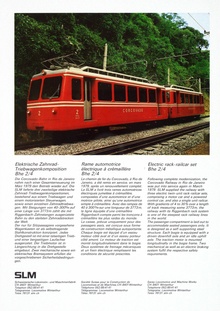Corcovado mountain railway
| Corcovado mountain railway | |||||||||||||||||||||||||||||||||||||||||
|---|---|---|---|---|---|---|---|---|---|---|---|---|---|---|---|---|---|---|---|---|---|---|---|---|---|---|---|---|---|---|---|---|---|---|---|---|---|---|---|---|---|
|
Motorcar of the Corcovado cable car
| |||||||||||||||||||||||||||||||||||||||||
| Route length: | 3.824 km | ||||||||||||||||||||||||||||||||||||||||
| Gauge : | 1000 mm ( meter gauge ) | ||||||||||||||||||||||||||||||||||||||||
| Power system : | 800 V 60 Hz ∆ | ||||||||||||||||||||||||||||||||||||||||
| Rack system : | Riggenbach | ||||||||||||||||||||||||||||||||||||||||
|
|||||||||||||||||||||||||||||||||||||||||
The Corcovado mountain railway is a meter-gauge rack railway with ladder rack according to the Riggenbach system and leads to the 710 m high Corcovado , one of the landmarks of Rio de Janeiro . The Corcovado mountain railway is one of the few railways that runs on three-phase current . It therefore has two contact wires (for two phases), just like the Jungfrau Railway and Gornergrat Railway ; the third phase is the rail.
history
The order to build the railway was placed on January 7, 1882 by Emperor Peter II . The two engineers Teixeira Soãres and Francesco Passos received a concession for the construction. It was opened in 1884, although it has only been possible to reach the summit since July 1, 1885.
In 1910 the railway was electrified. For this purpose, the Swiss Locomotive and Machine Factory (SLM) delivered three two-axle three-phase locomotives in 1909, similar to the Jungfrau Railway type He 2/2. The Corcovado Railway was the first electrically operated railway in Brazil .
Route and operation
The route runs on a single track and has some passing points, some of which are used as stopping points (some only for residents). The Paineiras siding, which is designed as a return track, offers a special feature.
The starting point of the train is at a height of 40 m. ü. M . With an average gradient of 16.7%, the train travels the 3824 m long route in 25 minutes to an altitude of 680 m. The steepest section has up to 30%. Uphill with a maximum of 15, downhill with 12 km / h. The cog railway traverses the 40 km² Tijuca Rainforest National Park, which opened in 1961, on its way to the summit of Corcovado .
Up to 2019, three double-powered railcars, again built by SLM in Winterthur in 1975 , were in service, which could accommodate a maximum of 121 people. A fourth railcar was identical to the valley-side half of the double railcars. The vehicles came into use from 1979 after the infrastructure had also been modernized. They were replaced in 2019 by new vehicles manufactured by Stadler Rail in Switzerland. Instead of 15 km / h, the new vehicles now reach a maximum speed of 25 km / h. The ascent takes another 15 minutes. During the descent, energy is fed back via the recuperation brake , which leads to savings of 75% in electricity consumption.
gallery
literature
- Walter Hefti: The world's rack railways. Birkhäuser Verlag Basel and Stuttgart 1971, ISBN 3-7643-0550-9
- Walter Hefti: Cog railways of the world, addendum. Birkhäuser Verlag Basel and Stuttgart 1976, ISBN 3-7643-0797-8
Individual evidence
- ↑ From Winterthur to all over the world - SLM locomotives. In: www.sbbhistoric.ch. Retrieved April 27, 2016 .
- ↑ Dirk Vogt: New railcars for Trem do Corcovado in Rio de Janeiro . In: Eisenbahn-Revue International 2/2020, pp. 69–72.
- ↑ Stadler Rail in Brazil: the miracle of Rio de Janeiro









